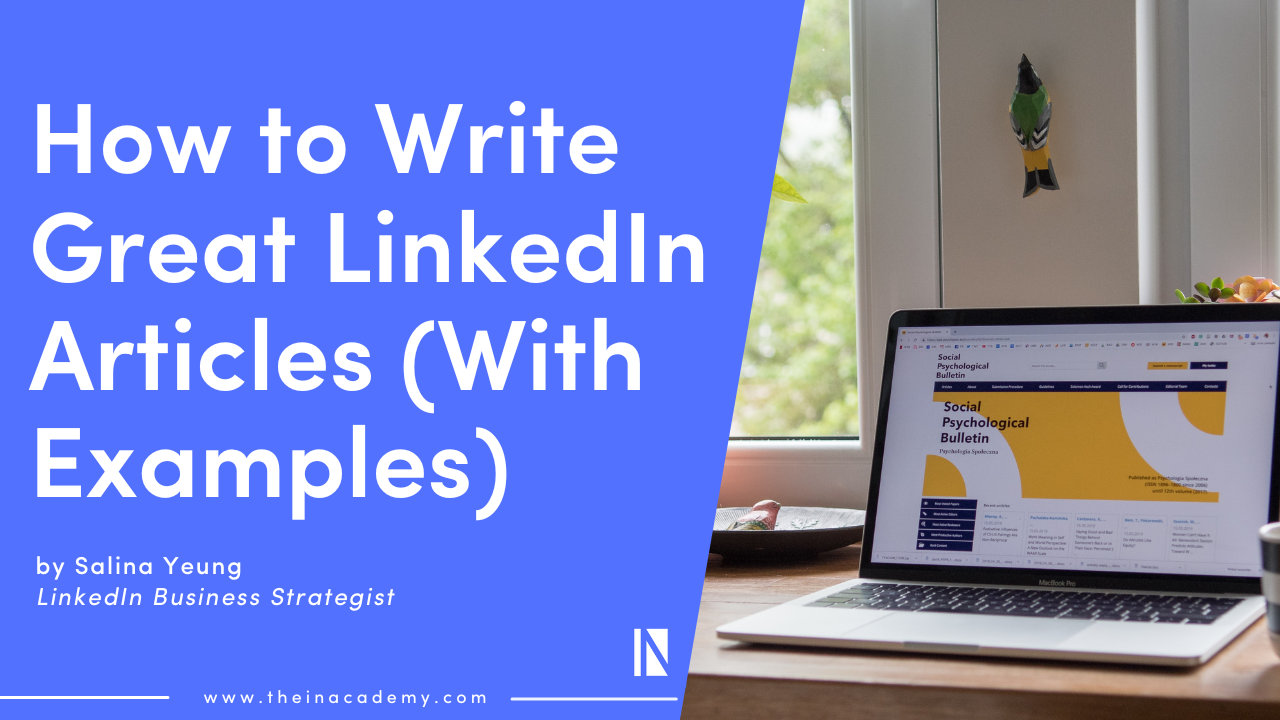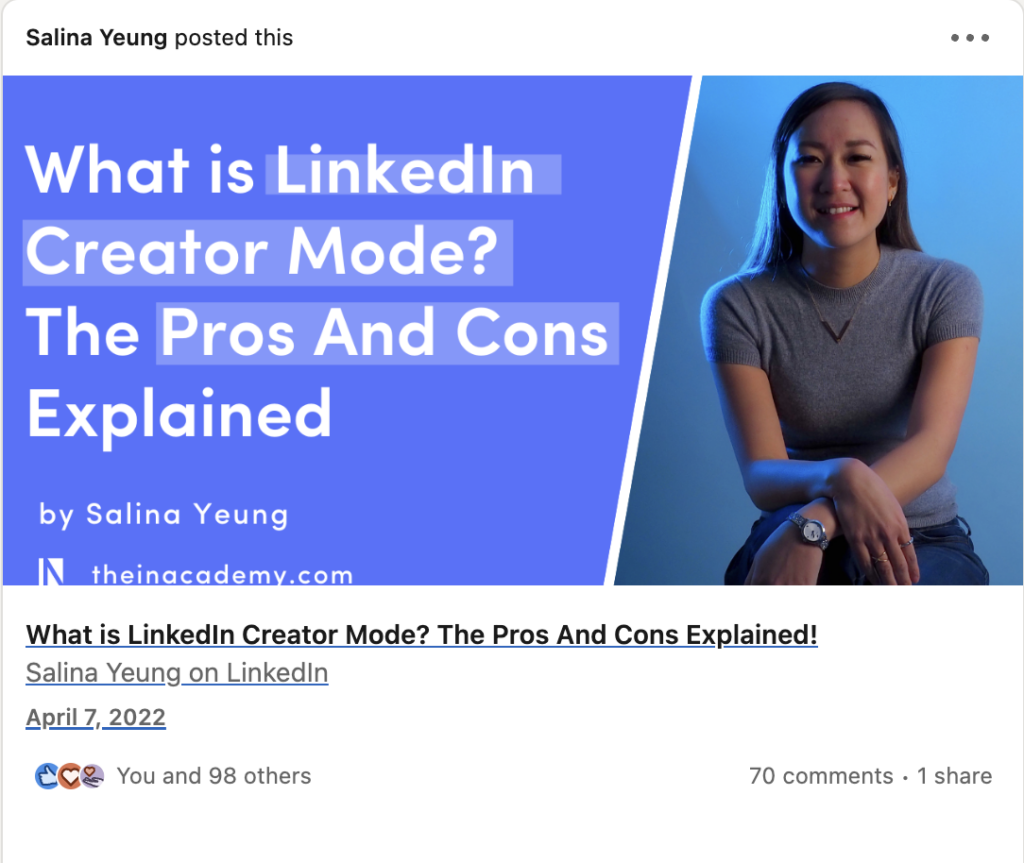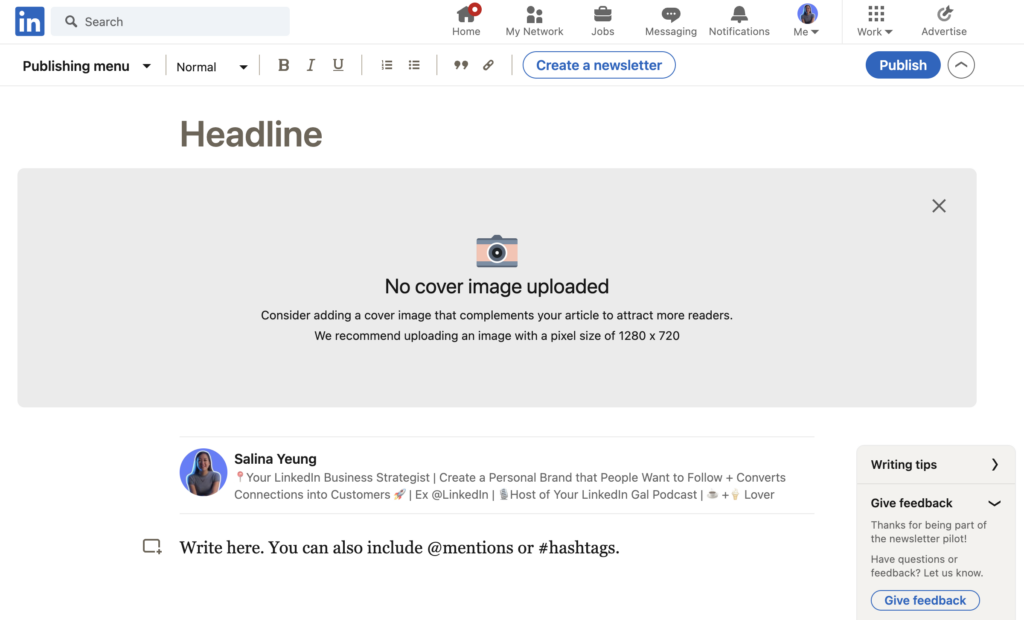On its surface, writing a LinkedIn article may seem unnecessary. It is an unpaid service that has no guarantee of helping advance your career prospects.
However, the truth is that well-written LinkedIn Articles provide many benefits to their authors. The benefits of writing a LinkedIn Article more than make the endeavor worth the time investment.
Otherwise, why are others still doing it? Let’s dive in and see what LinkedIn articles can do.
Table of content:
- What Is A LinkedIn Article?
- Benefits of Writing LinkedIn Articles
- How to Write a Great LinkedIn Article
- Examples of Great LinkedIn Articles
What Is A LinkedIn Article?
Articles are different from updates. Basically they are longer, in-depth blog liked pieces where you can create and publish on LinkedIn for you to share content about:
- Thought leadership
- Professional experiences and anecdotes
- Industry insights and expertise
- Advice for other professionals
- Opinions on developments in your field
- Content marketing messages in support of your brand
Benefits of Writing LinkedIn Articles
In our own opinion, we see there are three main benefits of writing LinkedIn articles.
Establishes You as a Thought Leader
Something critical in any industry is establishing yourself as a thought leader. Businesses are looking for candidates who are experts in their fields. An article outlining your expertise allows you to position yourself as precisely that.
Candidates could have similar levels of expertise on any given topic. However, from the employer’s perspective, the ones who have written a well-researched, competently written article have already proven their knowledge. This gives them a leg up on the other candidates.
Articles Help Grow Your Reach
At its core, the purpose of LinkedIn is to amass relevant connections that allow one to build a network within their field. An excellent article will resound among industry insiders, allowing you to make contact and grow your own network.
Additionally, LinkedIn articles rank on Google. So, if yours does well enough, it will reach those who are searching for particular topics that you wrote about before. If an employer is looking for someone to handle a niche subject for their company, odds are they will reach out to any individual whose name comes up on the first page of the search results.
LinkedIn Provides Detailed Analytics on Articles
Finally, LinkedIn provides detailed analytics to all users who write on their publishing platform. You will know how many people clicked on your article, what areas it generated the most interest in, the careers of those who read it, and much more.
Not only will this help you understand the audience that is looking for information on the topics you are writing about, but it will help you shape your future articles. Detailed analytics let you know if you are heading in the right direction or if you need to change tack for the next one.
How to Write a Great LinkedIn Article
If you have decided on writing a LinkedIn article, it is important to make sure it is amazing.
Unfortunately, we do not all write for a living. For those inexperienced in delivering professional quality articles, writing one for all your connections can be concerning. It might feel a bit like being asked to read your essay in front of your class.
But LinkedIn articles are not written exclusively by professional writers. While it may seem daunting, with enough effort you can write an article any professional would be proud of.
Choose Your Topic
The most important aspect of writing a LinkedIn article is choosing what you want to write about. That is because you need to balance three critical factors at this part of the process:
First, you want to make sure that you are writing about something you are knowledgeable about. This will make actually writing the article significantly easier because you will be more comfortable talking about it and need to do a lot less research ahead of time.
You also want to make sure you are writing about something that people in your industry will read. Consider your audience: for instance, if you’re writing for software engineers, what topics would they want to hear about? What’s relevant to their field?
In a similar regard, you also want to find something unique to talk about. This means finding a new spin on a popular topic, discovering interesting new ideas to talk about, diving into niche subject matter, or anything else that is interesting and engaging.
These three aspects are often at odds with one another. There are many ways to go about balancing them, but the best thing you can do is research, research, research. Look at what people are talking about and find interesting topics not being discussed in your field.
Choose Your Headline
Headlines are critical in getting the reader’s attention. They need to be relevant to the topic at hand — no one is ever happy to read an article after a clickbait headline brought them there — while also garnering the reader’s attention.
In general, we encourage article headlines to be succinct and to the point. “Mitosis: Understanding Cell Division, the Contemporary Research Surrounding It, and the Future of the Industry” is a mouthful and insults the reader’s intelligence by over-explaining its purpose.
Instead, something like “Three Contemporary Mitosis Studies you Should Know” clearly states its purpose without over-explaining itself to the reader. Little changes like this can make a world of difference in the reader’s eyes.
That said, don’t go too far in the other direction. “Five Common Interview Mistakes and How to Avoid Them” is still a lot better than “Common Interview Mistakes” because it better prepares the audience for the structure and purpose of the piece.
Format Your Article for Easy Reading
There are a few tricks professional writers use to increase engagement in their articles. While a whole article could be written about these tricks, here are three of the most common ones:
- Keep your paragraphs and sentences relatively short and concise. When speaking to a business-oriented audience, you want to get to the point as quickly as possible. Dense, flowery text does not do that.
- If possible, include images to break up the text. Particular attention should be paid to the banner image, as it (along with the headline) will be your article’s first impression. Spend
- While LinkedIn Articles can be up to 125,000 characters, we recommend writing about 500-750 words an article. This retains reader engagement throughout the piece. Once your article reaches over 1,000 words, it might be time to consider cuts.
When you are doing edits, always ask yourself: “Is this section really necessary?” Often, you’ll find that you’re unnecessarily discussing tangential topics that could instead be their own article.
Examples of Great LinkedIn Articles
For the last section of this article, we’ve found three excellent LinkedIn Articles and written a short explanation as to why they are effective. We hope that with these articles in mind you can get a sense of direction for your own articles.
How To Get Started With Your AI Journey by Bernard Marr
Bernard Marr is one of the premier article writers on LinkedIn, making him an ideal candidate to kick off our example section. In this article, Marr provides a thorough overview of AI, what it can do for one’s business, and how to practically begin implementing it.
This article is a great teaching tool because it demonstrates the tried and true tactic of delivering well-researched content that people want to read. AI is a topic few want to dive into because of its inherent complexity, which makes practical guides for beginners a relative gap in content surrounding it.
Marr pounces on that opening and delivers an article that provides an excellent introduction to AI implementation. At the moment of writing, this article has over 350 likes and 20 comments.
It’s Time for a New Definition of Success by Jeff Haden
In this article, Jeff Haden discusses how one’s personal definition of success will often differ from what society’s overall definition is. Haden cites anecdotes and experiences from his own life en route to delivering an excellent thesis statement.
What we really like about this article is that it is interesting for just about anyone to read. In tackling a broad subject, Haden can reach a wide audience and receive additional engagement. At the moment of writing, this article has over 700 likes and 85 comments.
Five Business Lessons from Radio Disney by Dave Kerpen
Finally, we have an article from Dave Kerpen written in the traditional “five tips” fashion. In it, Kerpen does exactly as the title says: extrapolate five lessons from his time working at Radio Disney.
We wanted to highlight this because of its accessibility. The listicle is used because consumers respond well to it, and having Disney in the title piques the average reader’s interest.
The article itself has relatively conventional advice — be persistent, prioritize connections, etc. — but it still received 150 likes because of its SEO-friendly formatting. This article provides a lesson in how far a little forethought in formatting and marketing can take your article.
Are You Ready to Write Your First Article?
If you are planning to start your own blog, I suggest you try giving LinkedIn articles a shot first and see if there is any traction on your topics and content.
You will eliminate the time needed to build your own site and get way fast response to see if your audience enjoys what you write before you invest more time and effort.
And if you are looking for more help to improve your LinkedIn game, we run FREE LIVE Masterclasses from time to time.
Join me [in]side Content Conversion System and build out the foundation for your Content Pillars, Audience Personas, 90-Day Plug & Play LinkedIn Content Prompts. my signature Copywriting Techniques AND…
Your own [in]sider Hub – All the steps, tools, and templates I created for all my clients to PLAN and ORGANIZE their Content on LinkedIn all in ONE place!
theinacademy.com
Take a look around.
Get Insiders Scoop.
Inside the Algorithm is your weekly download of all things business and magnetic content marketing, from exclusive LinkedIn insider Tips by Salina & Faisal to incredible guest contributors.
JUICY DEETS EVERY WEDNESDAY MORNING!







